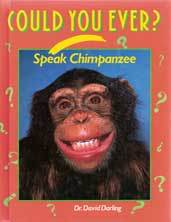COULD YOU EVER SPEAK CHIMPANZEE? Glossary
apes
Apes belong to the same large group of animals as lemurs, monkeys, and human beings. Together, this group is known as the primates. Apes are large, tailless primates, more intelligent than monkeys, that swing through the branches of trees using just their arms.
bivouac
A temporary camp built hastily using whatever materials are available. The "bivouac" made by army ants uses no material at all other than the living bodies of the worker ants hooked together by their legs.
cetaceans
The scientific name give to the sea mammal group that includes whales, dolphins, and porpoises.
communicate
To communicate is to send and receive for information.
cortex
In humans and more advanced mammals, the large outer part of the brain that handles abstract thinking. Our ability to talk, reason, plan ahead, and remember things from the past is centered in the cortex.
echolocation
The process by which whales send out sound waves and interpret their reflected echoes to determine what objects lie around them.
extinct
No longer living anywhere on Earth; many animal and plant species have become extinct.
gesture
A sign made by moving part of the body. For example, when we nod it is a gesture to show that we agree with something. Many animals use gestures to exchange messages.
hertz
A unit used to measure the frequency of sound. It gives the number of waves of sound that pass a certain point each second.
instinct
Something an animal can do without having to learn it. For example, it is an instinct for a baby to cry. Instincts are passed on from one generation to the next at birth. A great deal of animal behavior, especially among simpler creatures, is instinctive.
language
A system used by an animal to communicate with others of its kind or with other species.
luna moth
A beautiful pale green moth, native to North America, that has a long slender tail and hind wings.
macaque
A type of monkey with a long snout like that of a dog. There are several species of macaque living in Asia and Africa.
pitch
How low or high a sound is.
posture
The positioning of the body in such a way that it has a certain meaning to others who are watching. For example, a dog will posture by pinning back its ears and drooping its tail when afraid.
predator
An animal that hunts and eats other animals which are its prey. For example, a lion is a predator, and zebra are among its prey.
social
A social animal is one that always lives in groups with others of its kind. Such creatures can defend themselves better against predators and find food more successfully than most other animals. Monkeys, prairie dogs, and termites are social animals.
species
Animals of a certain species have many important features in common. Most importantly, males and females of the same species can breed with one another to produce young.
symbol
A written sign, such as a letter or simple picture, that conveys information.
territorial
A territorial animal is one that considers some area of land, air, or water to be its own and will defend it, especially against others of its kind. Sometimes a group of animals, such as a pack of hyenas, will "own" a territory.
vervet monkey
A medium-sized, tree-dwelling monkey from Africa whose diet consists largely of fruit.
vocabulary
The range of words or calls an animal can make that have a specific meaning. Human vocabularies consist of tens of thousands of words that can be put together in countless ways. Animal vocabularies are much smaller and less complex.

